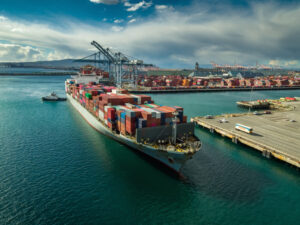Drewry's Container Insight Weekly has focused on US President Donald Trump raising fears of protectionism and reduced trade, questioning whether his rhetoric is just “hot air” and to what extent his trade liberalism will benefit trade.
Regardless of your political persuasion it has to be conceded that Donald Trump has hit the ground running since his inauguration, making good on some of his more contentious election pledges, including withdrawing from the Trans-Pacific Partnership (TPP) deal. This move was widely expected – indeed even the defeated Democratic Party nominee Hillary Clinton was lukewarm on the issue – but some his other actions have added to concerns that Mr Trump is sending America headfirst into a protectionist trade war.
Via Twitter he has threatened to impose heavy import tariffs on car makers (both native and foreign) bringing in vehicles from Mexico. Soon after, Ford cancelled plans for a new $1.6 billion plant in Villa de Reyes in Central Mexico and announced it would instead expand a facility in Michigan, although the company denied there was any link between Trump’s social media outburst and its decision.
For the likes of Drewry and others involved in the “art” of forecasting the new Trump administration does add considerable uncertainty and complexity. The new president has made a lot of bold promises and claims but what can he actually deliver? There are procedural obstacles and opposition from his own Republican Party for a start, but even if he can force through his agenda simply by leaning on companies, which he appears to be having some success with already judging by Ford’s retreat, is it possible to quantify the impact that would have on trade?
On the last point there is a surprising lack of scientific evidence that can help us to pin a number on the impact of trade liberalisation, or indeed de-liberalisation, on container traffic. There have been many studies on the subject, but as a 2015 review commissioned by the UK government’s Department for International Development (DFID) found there is very little consistency in the findings and many gaps in the evidence.
The review, conducted by the Overseas Development Institute (ODI), an independent London-based think tank, looked at 45 studies covering the impact of partially and fully implemented Free Trade Agreements (FTA) and weighted them for quality, giving more importance to studies that employed appropriate data and techniques. The seven quality criteria used by the authors can be found in the report.
In summary, the review found that the general consensus is that trade has grown as a consequence of FTAs, but there was widespread failure to attribute causality in the literature with no attempt made to construct a counterfactual taking account of what might have happened in the absence of the FTA.
Additionally, the review found that very few studies attempted to explain any lower than expected trade gains from FTAs, while there was little coverage of other factors that could explain FTA take-up, such as whether signatory states had the resources to handle the additional demand created by the FTA.
Table 1: Consensus opinion on the impact of Free Trade Agreements determined by DFID review 2015
Source: Stevens, C., Irfan, I., Massa, I. and Kennan, J. (2015) The Impact of Free Trade Agreements between Developed and Developing Countries on Economic Development in Developing Countries: A Rapid Evidence Assessment. London: Overseas Development Institute
The review also highlighted the shortage of any rigorous study into the effects of trade liberalisation on employment and earnings, issues that critics such as Mr Trump and some notable academics, including Nobel Memorial Prize winner Joseph Stiglitz, often cite as a major flaws of such trade accords.
The absence of quantifiable evidence means that we can only make broad generalisations about Mr Trump’s trade policies should they come into effect, which is clearly less than ideal. To try and sort the real facts from the alternative kind we will focus our analysis on the automotive sector that has been put in the spotlight by his recent social media output.
Figure 1: Production of motor vehicles (all types), millions, 2000-15
Source: The Organisation Internationale des Constructeurs d’Automobiles (OICA)
It is true that since the formation of NAFTA in 1994 Mexico has blossomed into one of the world’s leading producers of motor vehicles and parts as manufacturers from all over the world, including the US, have moved in. According to statistics from the Organisation Internationale des Constructeurs d’Automobiles (OICA) in 2015 Mexico made 3.6 million vehicles (passenger cars and commercial vehicles), of which over three-quarters were exported. Since 2000 production has risen at an average annual rate of 4.5% and alongside the rapid growth in vehicle production there has been an equally strong development of the auto parts industry, which the National Auto Parts Industry (INA) estimates has more than doubled in value since 2009 to exceed $85 billion in 2015.
Mexico is now the biggest provider of vehicles to the US with $47.3 billion of Mexican-made units crossing the border in the first 11 months of 2016. Another $51.6bn of parts made the same journey over the same period. It is not a one-way trade though as the US is on course to export nearly $30bn in vehicles and parts to Mexico this year, second only to Canada. The auto making trade is highly complex supply chain with parts and partially assembled units often moving across many borders.
The rise of the automotive sector in Mexico has been attributed in some quarters to its relentless pursuit of FTAs around the world. While it is true Mexico has been much more active on that front than the US, such analysis doesn’t consider whether the business would have arrived in any case to tap into the highly productive (and lower paid) workforce. For example, INA estimates that Mexico offers a 10% savings in auto parts manufacturing compared to costs in the US.
Figure 2: Top 20 motor vehicle manufacturers’ production in Mexico by origin, millions 2010 vs 2015
Note: For 2010 US manufacturers includes Chrysler, for 2015 Fiat Chrysler Automobiles is included in the non-US category
Source: The Organisation Internationale des Constructeurs d’Automobiles (OICA)
Figure 3: Top 20 motor vehicle manufacturers’ production in the US by origin, millions 2010 vs 2015
Note: For 2010 US manufacturers includes Chrysler, for 2015 Fiat Chrysler Automobiles is included in the non-US category
Source: The Organisation Internationale des Constructeurs d’Automobiles (OICA)
Moreover, even with its higher costs and fewer FTAs the US has hardly been ignored by the major vehicle manufacturers around the world. Since the global financial crisis-induced slump in vehicle production of 2009, the US has seen production rise by 16% CAGR, only two points below Mexico over the same timeframe. The thrust of the production recovery has not come from the US giants General Motors or Ford, but from foreign brands such as Toyota, Nissan and BMW.
OICA data indicates that from 2010 to 2015 non-US manufacturers upped their production in the US by 114%, whereas GM and Ford increased activity by only 9%. The figures are slightly skewed by the fact that following Chapter 11 bankruptcy reorganisation Chrysler is now under foreign control, but even if we are generous and assign the company as a US marque the trend stands.
It is clear that Mexico’s rise up the automotive ladder has not significantly impeded US production or jobs in the sector, which have swelled by about 50% since the recession to nearly 1 million, a sizeable number of which were generated by foreign companies. Of course, it is possible that with more liberal trade agreements the US might have been able to grow auto production and jobs even faster, or perhaps it would have taken greater investment in facilities and productivity to accelerate as quickly as Mexico. Either way, Drewry cannot believe that the way to stimulate the industry is via ultimatums over social media to foreign companies that are already helping to improve the economy.
Mr Trump’s attacks on the auto sector and Mexico also divert attention away from one of the main reasons that more cars are not made in the US, namely that American’s prefer the foreign alternatives. Data from Autodata Corp. shows that non-US manufacturers accounted for 68% of all light vehicle sales in the US last year with 11.9 million units sold, up 1% on the previous year. In contrast, GM, Ford and the small Tesla brand between them saw sales decline by 0.5%.
Figure 4: US light vehicle sales by origin of manufacturer, millions, 2015-16
Note: *Includes Fiat Chrysler Automobiles, which is an Italian-controlled Dutch multinational corporation
Source: Autodata Corp.
On balance there doesn’t seem to be sufficient evidence to justify Mr Trump’s position that Mexico is ‘stealing’ auto jobs from Americans, or indeed that Mexico’s more liberal trade policy is the sole reason for its fractionally faster production growth rate. However, without concrete scientific support it is not possible to dismiss the critics of globalisation that say it is a destructive force.
Our best guess is that Mr Trump will continue to make the same anti-FTA noises (digitally and verbally), which it has to be remembered was a significant reason for his election triumph, and that America will certainly backtrack from entering into any more broad agreements like the Transatlantic Trade and Investment Partnership (TTIP), but that ultimately it will not introduce any legislation that would harm its trade competiveness and risk job losses and higher prices at home.
Assuming we are correct and all that happens is a bit more symbolic relocating back to America as per Ford to satisfy Trump voters there shouldn’t be too much change to the status quo, meaning little adjustment to our container forecasts will be necessary.
We are not the only ones hoping for the best. The IMF recently upgraded its GDP outlook for the US by 0.1 point and 0.4 points for 2017 and 2018 respectively, but cautioned that the revised forecast was merely the most likely in a wide range of scenarios. As things stand the IMF thinks that fiscal stimulus will see economic output rise to 2.3% in 2017 and 2.5% in 2018.
If we are wrong, the likely losers will be the US. The size of the US market has until now been sufficient for foreign auto companies to continue investing in the country, but without any patriotic affinity they would likely retreat if uncommercial rules are enforced upon them. Reports that China could replace the US in the TPP agreement points to a future when the rest of the world moves on and simply trades more with each other. If Trump does impose trade barriers and high tariffs, other countries will definitely retaliate and so US exports will suffer.
Our view
As the first US president in decades to be openly protectionist, Mr Trump adds considerable risk to any international trade outlook, serving up a myriad of largely unquantifiable scenarios, whatever his true intentions may be. Proponents of trade liberalisation need to provide more scientific evidence of its beneficial impacts, not just on trade but on wider socio-economic issues.















